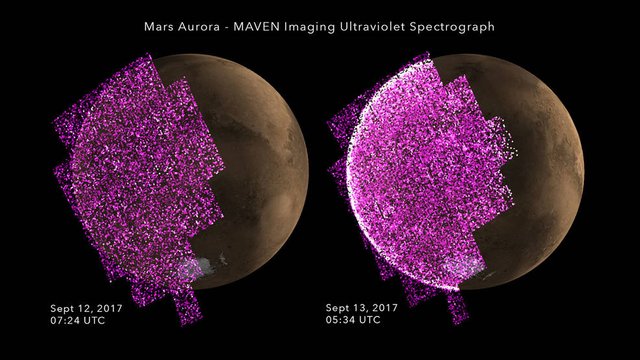Mars Hit with a Massive Solar Flare This Month/ A Similar Solar Flare Nearly Destroyed the Earth in 2012
 Image Credit
Image Credit
The above image was taken from the "Imaging Ultraviolet Spectrograph on NASA's MAVEN orbiter" earlier this month during a large solar storm.
The "Curiosity rover's Radiation Assessment Detector," or (RAD,) detected more than double radiation levels ever recorded since the launch of the RAD detector in 2012. The high-level readings lasted for more than two days.
Sonal Jain of the University of Colorado Boulder's Laboratory for Atmospheric and Space Physics stated that "the current solar cycle has been an odd one with less activity at its peak, and now we have this large event as we are approaching the solar minimum.
RAD Principal Investigator Don Hassler of the Southwest Research Institute's Boulder, Colorado, office, stated that "It will improve our understanding of how such solar events affect the Martian environment, from the top of the atmosphere all the way down to the surface."
The sun's "temper," goes through various stages that are usually quite predictable as far as solar activity is concerned. Solar events, such as the one that recently took place on Mars during a solar quieting period, was unpredictable and unexpected.

Eleven Year Cycle
The sun is 93 million miles away from earth, but high levels of solar activity have different effects here on our home planet.
The sun's "temper" varies within an 11-year cycle, typically taking about 5.5 years to move from the quieter period of solar minimum and on into a more turbulent solar maximum.
Solar Physicists monitor the sun's surface for sunspots, which are dark short-lived splotches that are caused by intense magnetic activity that tends to cluster in bands below the equator.
Sunspots sometimes erupt into massive solar storms that emit large streams of charged particles, (or coronal mass ejections) into space that are occasionally aimed at the earth. If a solar storm takes place that is aimed toward Earth, our magnetic field is bombarded by its charged particles, often seen on earth as beautiful auroras. As lovely as these natural events can be, If a solar storm is massive enough, it could potentially knock out power grids as well as satellites in orbit around the earth.
The Solar event that took place on September 12 - 2017, was so massive that it had the potential to even effect planets on the opposite side of the solar storm.
Earth has a strong magnetic field that concentrates the auroras near polar regions, while Mars does not have a strong magnetic field the entire planet lit up, "like a light bulb."

While data is still being looked at from this latest event, it is quite possible that a similar earth aimed solar flare would be at the level that scientists have been warning about for the past few years, that could knock out power grids and set us back decades.
Mars is located 141.6 million miles away from the sun, and if the solar activity that caused the massive global Aurora around the planet Mars had been aimed at Earth it's not difficult to see how massive earth aimed solar storms could cause very big problems for us here at home.
According to a New York Post article, we were very close to having this happen just a five years ago.
In an article by James Billington titled:
Solar flare nearly destroyed Earth 2 years ago: NASA
Billington wrote:
On July 23, 2012, Earth had a near miss with a solar flare, or coronal mass ejection (CME), from the most powerful storm on the sun in over 150 years, but nobody decided to mention it.
Visit the link New York Post Article to read more about this event.

Ref:
New York Post Article Link <---

September 30 - 2017

This post has received a 1.26 % upvote from @booster thanks to: @livingwaters.